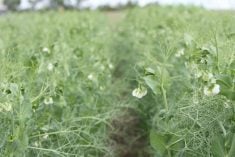June has been a cruel month for farmers.
As they finished seeding, the crop markets slumped.
But most advisers think the future is still bright, or at least parts of it will be, for the 2006-07 marketing year.
“We’re not done yet,” said Winnipeg market analyst David Drozd about the overall run-up in crop prices that had occurred until the recent slump.
“I believe the grain markets will still be the next commodity that funds and speculative buyers sink their teeth into, and we see grain prices continue to move higher.”
Read Also

Phosphate prices to remain high
Phosphate prices are expected to remain elevated, according to Mosaic’s president.
But Calgary analyst Errol Anderson thinks there is a risk that some markets, in particular wheat, may have already reached their peaks and offer only sporadic rallies over the next year.
“It’s possible that the highs are in for wheat,” said Anderson.
Commodity markets have seen wild action the past year, and the long-suffering agricultural markets have been swept up into the excitement. In the late winter and spring, wheat soared and more recently canola finally pulled itself out of a prolonged slump.
But in the last couple of weeks, commodity prices generally have tumbled, including agricultural commodities.
Many market watchers are debating whether this marks a correction, which means a short-term price retreat before another long-term price increase, or whether the commodities boom is over.
Drozd, who specializes in technical analysis, believes the recent price drop is only a correction. His chart analysis tells him that the way forward is up.
Once prices return to the spring price level, which may take some time, they’re likely to catch fire again.
“Technically speaking, once those markets exceed the highs we just had here in May, the grain markets will begin another leg higher,” said
Drozd.
He expects Chicago corn prices, which topped out at around $2.65 US per bushel in May, to head toward $3.35 per bu. He expects wheat to break through $4.33 per bu., its spring peak, and chase a $6 price.
“It’s likely to happen. What I’m not sure about is when,” said Drozd.
Anderson is more skeptical. He said it may happen, depending on crop conditions and other factors, but it also may have topped out.
If that’s the case, there are likely to be rallies throughout the winter, but there may not be new highs set. For farmers, the key to successful marketing may be to take advantage of the rallies and not endlessly wait for new peaks, he said.
For cash flow, farmers should sell into whatever summer rallies develop to cover fall bills. They can hold the remaining crop for a possible winter rally.
Mike Krueger, who operates North Dakota advisory service the Money Farm, doubts the 2006-07 wheat highs are in yet and believes this present slump is a correction.
He thinks the longer term outlook for both corn and soybeans is rosy.
But he thinks wheat will peak sooner than other crops, and he is already urging farmers to cash in on 2007-08 wheat prices, because the rally of the last few months will spark wheat acreage increases around the world he thinks will weigh on prices next year.
“I’m almost more willing to sell 2007 wheat production than 2006 production,” said Krueger.
While early June dealt a blow to grain prices, all three analysts think farmers should hold on and wait for better prices.
Anderson thinks rallies will offer farmers marketing opportunities, but not as strong as hoped for.
Krueger thinks farmers will be rewarded if they wait out this correction and start thinking of pricing again when the market is rising again.
And Drozd thinks farmers should forget about the market this summer. There’s no point selling into a correction, and there are better prices coming.
“I’m telling them to focus on the crop, and prices will take care of themselves,” said Drozd. “Don’t be too aggressive. This is not the year for that.”















